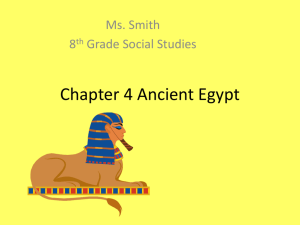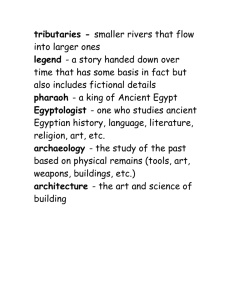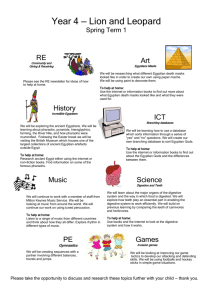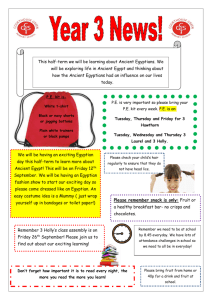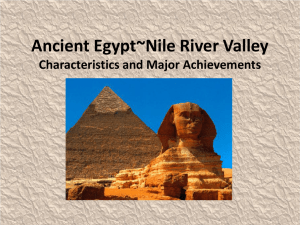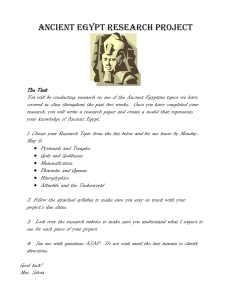Ancient Egyptian Religion PowerPoint
advertisement
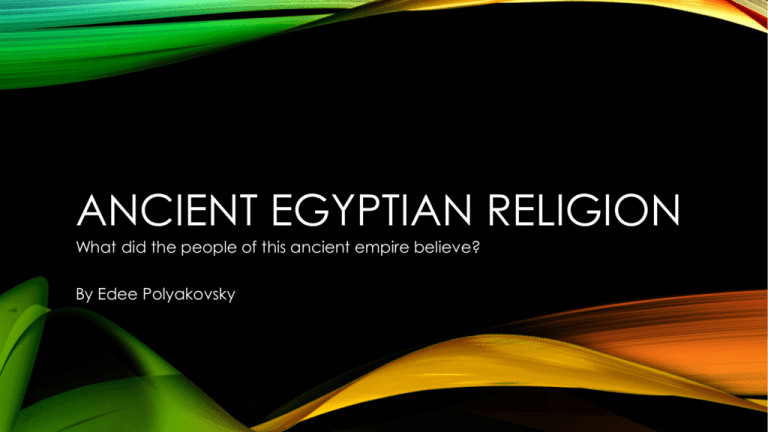
ANCIENT EGYPTIAN RELIGION What did the people of this ancient empire believe? By Edee Polyakovsky GODS, GODDESSES AND MYTHS Below is a picture showing Ra on his night time journey through the Duat. Every night when the sun sets, Nut swallows Ra and every morning she gives birth and the sun rises. This painting shows Nut the sky goddess, Geb the earth god and Shu the air god. It is Shu’s job to keep Nut and Geb apart. Above is a picture of Osiris, the lord of the underworld siting on his throne. EVERY DAY RELIGIOUS LIFE On the right is a painting of Egyptian workers getting grain ready for sacrifices. The picture shows all of the steps that they would go through to make food “edible” for their gods. Below is a picture of the Ancient Egyptians and the god Anubis putting together a sarcophagus. The Ancient Egyptians integrated their religious practices into their society very well. Even common peasants were religious, though they didn’t get fancy burials. Religion wasn’t the only thing in the Ancient Egyptian’s lives. They still had to provide for themselves. The picture on the left shows a man plowing his field (the cows are hitched to the plow). THE PHARAOH’S RELIGIOUS JOB The Ancient Egyptians believed that the Pharaoh was almost like a god and he/she could use magical powers. The Pharaoh’s chief adviser was the head magician (in the leopard skin). The Pharaohs were not sit by kings. They were the kind of kings that were examples in both the military and religion. In fact, the pharaoh was presumed to be the most religious person (along with the priests). The Ancient Egyptians believed that the Pharaohs ruled side by side with the kings of the gods. DEATH The picture on the right is another image from the Book of the Dead. This painting shows one of Anubis’ servants and Ammit the devourer, the demon that ate the hearts that were heavier than the feather of truth. Above is a painting depicting Anubis weighing a heart against the feather of truth. This picture is right out of the Ancient Egyptian Book of the Dead that all Pharaohs were buried with. This picture is a painting on a tomb wall showing the god Anubis caring for a mummy. Mummifying was a very important religious practice for the Ancient Egyptians. THE PARTS OF THE SOUL The picture below shows both a ba (flying above) and a seut or shadow (in the doorway). This picture shows a ba rising off of a mummy. The ba was a spirit like form that usually took the form of a bird. A person could see through the eyes of their ba and it could go anywhere. Above is another picture of a ba. It is watching a heart being weighed against the feather of truth (the rest of scales and other things are not shown). Many Greek and Roman scholars wrote about the Ancient Egyptians, including Plutaren, who in the 1st Century CE wrote an essay on Osiris and Isis and the myths that involve them together. INTERPRETATIONS Writings about the Ancient Egyptians were mostly done by the Greeks and Romans, like on the Rosetta Stone (below). Almost every thing we know about the Ancient Egyptians was written down in/on the tombs of the Pharaohs and nobles. BIBLIOGRAPHY • "Ancient Egyptian Gods and Godesses." N.p., n.d. Web. • "Ancient Egyptian Religion." N.p., n.d. Web. • "Egyptian Religion." Encyclopedia Britannica Online. Encyclopedia Britannica, n.d. Web. 30 Nov. 2015. <http://www.britannica.com/topic/Egyptian-religion>. • "Ancient Egypt." Encyclopedia Britannica Online. Encyclopedia Britannica, n.d. Web. 02 Dec. 2015. <http://www.britannica.com/place/ancient-Egypt>. • "The Cultural Background." Encyclopedia Britannica Online. Encyclopedia Britannica, n.d. Web. 02 Dec. 2015. <http://www.britannica.com/science/death/The-cultural-background#toc22184>. • "Body and Soul." Ancient Egypt:. N.p., n.d. Web. 06 Dec. 2015. <http://www.reshafim.org.il/ad/egypt/religion/body_and_soul.htm>. • The Kane Chronicles by Rick Riordan

